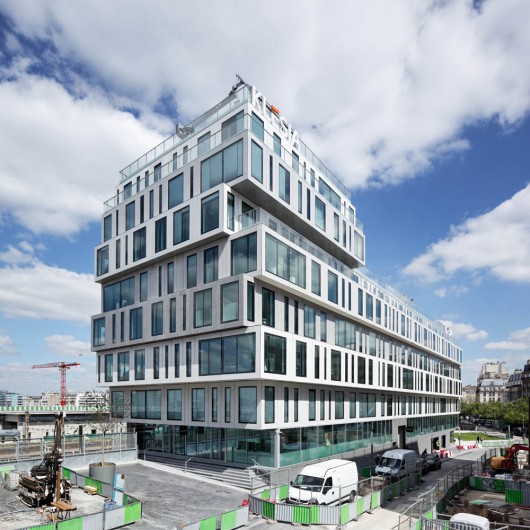 |
| Source: buildipedia.com |
Whitney Museum of American Art, New York City, USA, 1966 designed by Marcel Breue
Marcel Breuer's granite-clad Whitney Museum of American Art has loomed over 75th Street and Madison Avenue in New York's Upper East Side for over 40 years. After repeated attempts to expand and add much needed gallery space, the Whitney has officially announced it is headed downtown. Renzo Piano designed a new building for the Whitney in the hip Meatpacking District adjacent to the High Line, an abandoned, elevated railway that has been converted into a highly publicized park. -- Buildipedia.com
Whitney Museum Meatpacking District, Manhattan Renzo Piano Building Workshop
Piano’s signature style — elegant, subdued, confident — is evident in renderings for the new Whitney. The asymmetrical glass, steel, and concrete building will rise near the southern entrance of the High Line. -- Architectural Record
 |
| Source: Iwan Baan |
NYC New Museum, New York City, USA, 2007 designed by SANNA
The shift of each box creates space for a terrace or skylight, providing views of surrounding buildings from each stairwell, while its ground floor engages the street with transparency.-- Architectural Record News, November 29, 2007Another article from Architecture Today.
Watch a video from ArchDaily
 |
| Source: Arnewde.com |
Ftown Building, Sendai, Japan, 2008 designed by Atelier Hitoshi Abe
A typical tenant building has a tree-like organization in which each floor is independently accessed by elevator from the entrance at the first floor. -- Arnewde.comRead the post in ArchDaily
 |
| Source: Peter Krapež archdaily.com |
Residential Building, Nova Gorica, Slovenia, 2010 designed by Ravnikar Potokar Arhitekturni
The basic idea lies in the layering of two storeys by displacing their floor plan – the elementary square of the floor plan is moved around the vertical core thus creating overhangs on which terraces are placed. The vertical line of the residential tower is cut up and transformed into horizontal layering, providing the tower with the necessary dynamics. -- ArchDaily
 |
| source: Robert Granoff archdaily.com |
15 Union Square West, New York City, New York, USA, 2011 designed by ODA Architecture and Perkins Eastman Architects
The design creates 7 new floors – a series of elegant glass cubes set at different angles to allow for vivid, unobstructed park and city views with spacious, private outdoor terraces. -- ArchDaily
 |
| Source: Sarah Blee architecturetoday.co.uk |
Museum Aan de Stroom (MAS), Antwerp, Belgium, 2011 designed by Neutelings Riedijk Architects
The offset sandstone boxes each project 12m from a concrete service core, held firm by massive steel trusses that remain exposed in the galleries. -- Architectural Review, June 29, 2011Another article from Architecture Today.
 |
| Source: Shai Gill archdaily.com |
Terrence Donnelly Health Sciences Complex, Toronto, Mississauga, Canada, 2011 designed by Kongats Architects
A series of stacked ‘boxes,’ where each ‘box’ shrinks or enlarges from
floor to floor to best facilitate desired program adjacency
requirements while maximizing views and access to daylight. The outdoor
spaces created between the stacked ‘boxes’ accommodate accessible
terraces overlooking gardens of indigenous planting. The teaching, office
spaces and laboratories float in greenery. -- ArchDaily
 |
| Source: Iwan Baan archdaily.com |
Bioinnova, Culiacán Rosales, Sinaloa, Mexico, 2012 designed by Tatiana Bilbao
We were asked to do a flexible most rectangular space, so we decided to do identical floors and shift them accordingly to interior program and sun shading, except one floor, that was shifted 180 degrees because it holds the most important program in the building: the accelerator and incubator, where students can have an office and the university will help them improving and connecting their business to achieve the level of a profitable company. -- ArchDaily
 |
| Source: Takeshi Yamagishi archdaily.com |
Asakusa Culture and Tourism Center, Taito, Tokyo, Japan, 2012 designed by Kengo Kuma & Associates
The center extends Asakusa’s lively neighborhood vertically and piles up roofs that wrap different activities underneath, creating a “new section” which had not existed in conventional layered architecture. Equipments are stored in the diagonally shaped spaces born between the roof and the floor, and by this treatment we could secure large air volume despite its just average height for high-and medium-rise buildings. Furthermore, the roofs not only divide the structure into 8 one-storied houses but also determine the role of each floor. -- ArchDaily
 |
| Source: Luc Boegly archdaily.com |
Aquitanis Headquarters, Bordeaux, France, 2013 designed by Platform Architectures
The subtle layering and misalignment of the various shapes, level upon level, is disconcerting for the visitor, as it appears defy the laws of gravity. -- ArchDaily
 |
| Source: Vincent Fillon archdaily.com |
Strato Office Block, Boulevard Pereire, Paris, France, 2014 designed by Hardel et Le Bihan Architectes
....the mass of the structure is broken down into several horizontal, floor-high strata to reduce the monumentality of the building and lighten the tertiary character of the smooth facades. Emphasised by the use of various shades of grey, the recesses and projections mark out the horizontal and accentuate the view over the new street. -- ArchDaily
 |
| Source: Miguel de Guzman archdaily.com |
Cultural Center La Gota - Tobacco Museum, 10300 Navalmoral de la Mata, Cáceres, Spain designed by Losada García
The geometry of the Centre is attributed to the structure of the tobacco plant with the principle of equality and diversity that we also see in these vegetables -the leaves are similar but different at the same time. The five floors of the Centre are set on five displaced boxes, one above the other. The floors are staggered in the areas where boxes are flying to create the effect of a box "on the other." -- ArchDaily
Thanks for this. I really like what you've posted here and wish you the best of luck with this blog and thanks for sharing. Thai architects
ReplyDelete